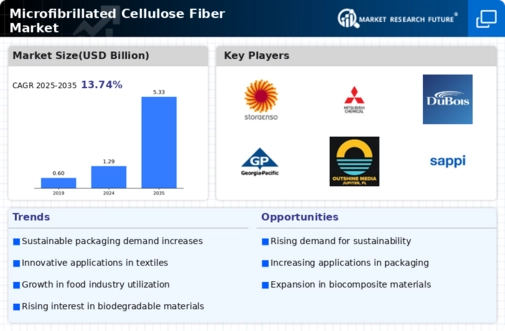The Microfibrillated Cellulose Fiber Market is an evolving and competitive landscape characterized by increasing interest in sustainable raw materials and innovative applications. Microfibrillated cellulose fibers, derived from natural sources, have gained traction across various industries, including packaging, textiles, and personal care, due to their exceptional mechanical properties and biodegradability. As the demand for eco-friendly alternatives escalates, manufacturers are investing in advanced technologies to enhance production processes and improve fiber characteristics. The competitive dynamics are further influenced by strategic collaborations, mergers, and partnerships among market players, contributing to product innovation and expanded geographical reach.
This competitive environment necessitates a deep understanding of market trends, customer preferences, and regulatory frameworks that govern the use of cellulose-based products.Stora Enso has established itself as a significant player in the Microfibrillated Cellulose Fiber Market, leveraging its strong background in renewable materials and sustainable practices. The company's commitment to innovation is evident in its investments in research and development, focusing on enhancing the properties of microfibrillated cellulose fibers. Stora Enso's extensive manufacturing capabilities enable it to produce high-quality cellulose fibers that meet diverse industry needs.
The company has also developed a robust distribution network, ensuring efficient supply chain management and response to market demands. Moreover, Stora Enso's emphasis on sustainability aligns with the increasing consumer and regulatory focus on environmentally friendly products, positioning it favorably in this competitive market.Finnish Chemical Industries has made a noteworthy entry into the Microfibrillated Cellulose Fiber Market, capitalizing on its expertise in the chemical processing sector. The company is recognized for its innovative approaches to producing microfibrillated cellulose, employing cutting-edge technologies that enhance fiber functionality and applicability.
Finnish Chemical Industries has a strong product portfolio that caters to various industries, including packaging and construction, thereby widening its market presence. The company's operational efficiencies and commitment to quality have helped it build a solid reputation among customers looking for reliable and high-performance cellulose fibers. By continually exploring new applications and collaborating with research institutions, Finnish Chemical Industries is well-positioned to take advantage of emerging market opportunities and address the growing demand for sustainable materials.



















